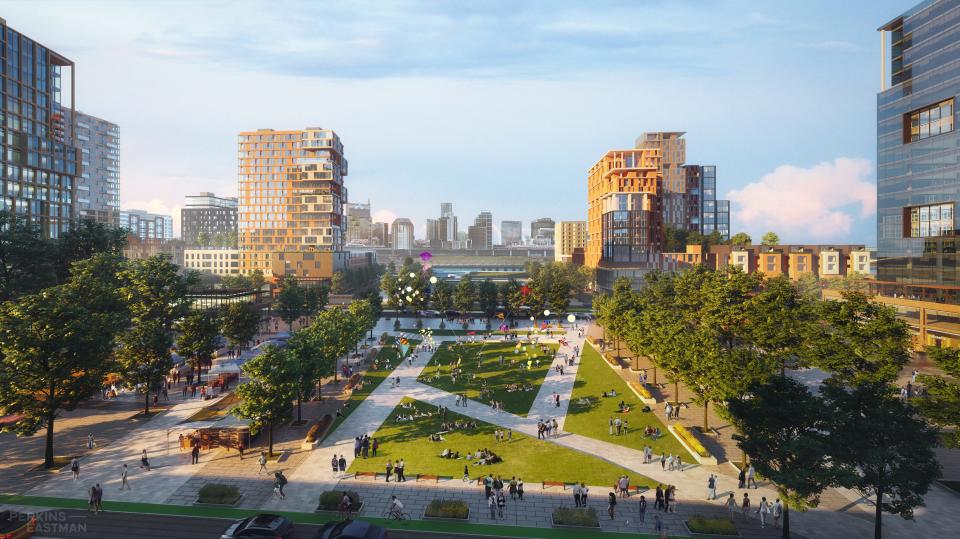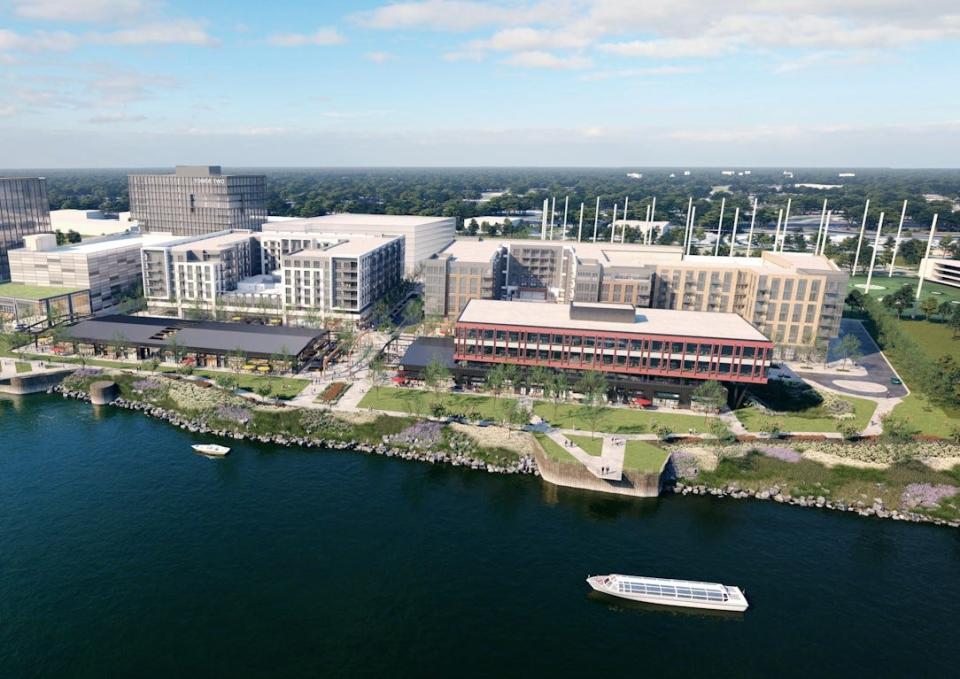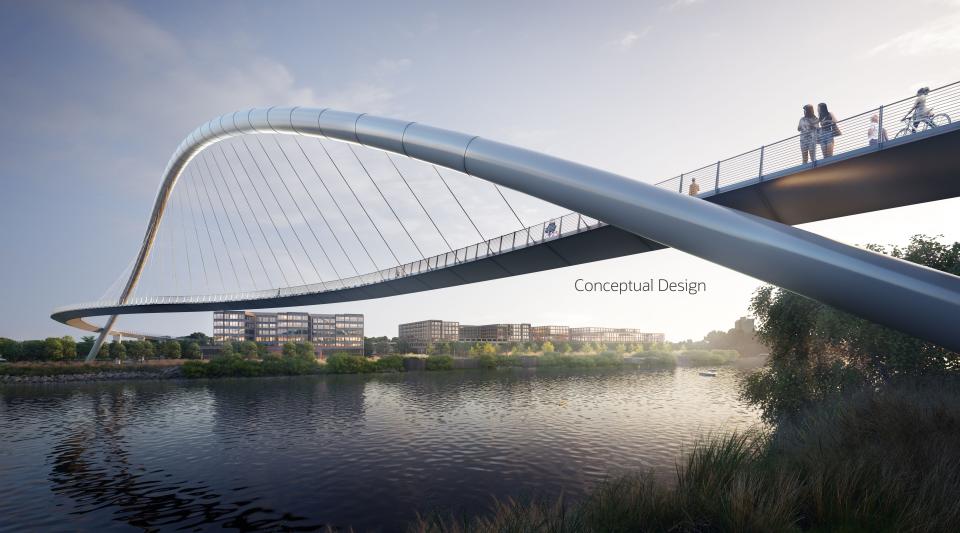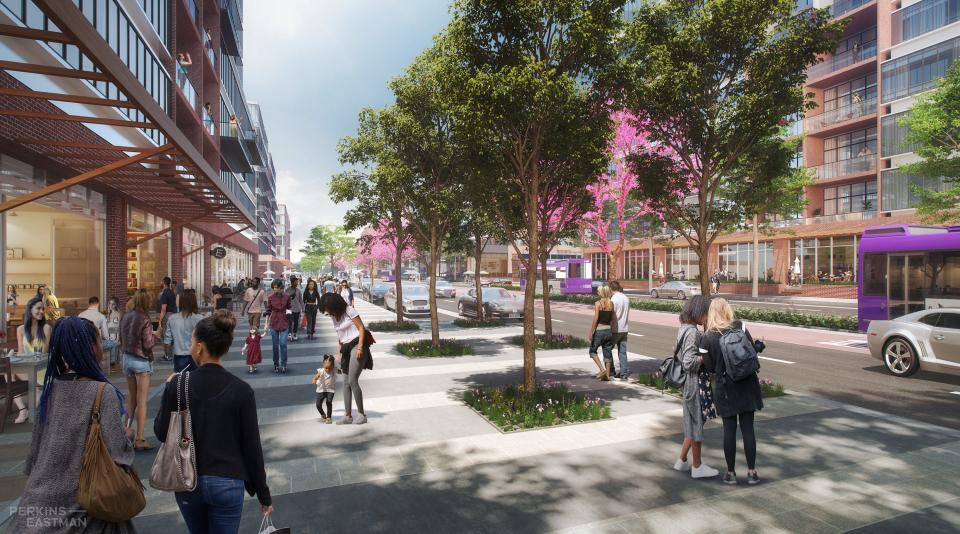What's next for Nashville's East Bank? Negotiations are just beginning.
The construction timeline for the new Titans Stadium is in motion, but Nashville's leaders are focused on the bigger picture: the hundreds of public and private acres that make up the East Bank.
Building the infrastructure to support the massive redevelopment of the mostly industrial land is no small feat, with estimated costs topping $700 million and no set-in-stone plan for how to pay for it. The East Bank is a project that's captured national attention, and one that will take far longer than the three years planned for the construction of the new stadium.
Negotiations with the city's chosen master developer — Boston-based The Fallon Company — have just begun under the leadership of new Nashville Mayor Freddie O'Connell. The city selected the company from a pool of eight applicants at the very end of former Mayor John Cooper's term.
Fallon has submitted two proposals for 30 of the approximately 117 Metro-owned acres on the waterfront. Their designs contemplate how to fit 2,000 required parking spaces for the Titans alongside the city's vision for the land: affordable housing, a transit hub, public greenspace and a vibrant collection of businesses.
The mayor's office began having direct conversations with Fallon in mid-October over what a master developer agreement could look like, Chief Development Officer Bob Mendes said during an Oct. 26 panel presented by The Nashville Post and Gensler.
"So far no offers have been exchanged," Mendes said, though he and others in the O'Connell administration are hoping to get there by spring.
But those 30 acres make up only a portion of Metro's East Bank acreage, let alone dozens of acres of privately held land in the area.
"It's going to take a while," Mendes said of the East Bank's revamp. "The Gulch, I think, took about 20 years to develop."
Ready, set, bid: Titans launch 3-year stadium construction timeline, call for proposals
Using Metro's land
Several Nashville mayoral administrations have tried to figure out how to embrace the Cumberland River but a fractured mobility network presented challenges, Metro Planning Executive Director Lucy Kempf said during the panel discussion.
The Second Avenue bombing on Christmas Day in 2020 forced planners to think about Nashville's riverbanks "more holistically," she said. "The private sector beginning to apply pressure on the East Bank" also spurred Metro into action to chart a better infrastructure grid for the area and purchase right-of-way before new private developments entrench the current disjointed street design.
Metro's Planning Commission approved the Imagine East Bank plan for a 338-acre stretch of the waterfront in October 2022. The city's vision features wide sidewalks for pedestrians, bike lanes, affordable housing goals, and a new transit hub on a new arterial boulevard running parallel to the river.

Metro owns approximately 117 acres of this land, including:
20 acres dedicated to the new Titans Stadium
About 30 acres of initial development in partnership with master developer Fallon
About 22 acres for future development
Roughly 45 acres for proposed public parks, streets and walkways
Cooper's redevelopment vision included moving the Tennessee Performing Arts Center from its James K. Polk Cultural Center location downtown to a new building on the East Bank. State lawmakers recently approved a $200 million grant for the relocation, but TPAC would need to contribute a 20% match to access the funding. Fallon's proposals contemplate constructing a new TPAC on Metro land, but no plans have been finalized.
East Bank Committee resurrected
Nashville Vice Mayor Angie Henderson appointed seven Metro Council members to continue work started by the East Bank Stadium Committee in the previous term.
District 5 Council member Sean Parker will chair the East Bank Committee, tasked with gathering and reviewing information spanning East Bank development and infrastructure and the new stadium.
"The stadium subsidy is a settled matter, but now we must ensure that our investments on the East Bank are strategic and benefit the city as a whole," Parker said in a statement on Oct. 27. "We’ve heard loud and clear that Nashvillians don’t want to just expand the downtown party district across the river. I am committed to conducting a transparent and collaborative process with the administration, the Council, and the public, including engagement with communities most impacted by the project.”
In addition to Parker, the committee includes:
At-large Council member Quin Evans Segall
District 2 Council member Kyonzte Toombs
District 6 Council member Clay Capp
District 15 Council member Jeff Gregg
District 17 Council member Terry Vo
District 19 Council member Jacob Kupin
The committee will hold its first meeting on Nov. 8.
Working with private development
Mendes said he's hopeful that doing construction in phases will help the city and developers strike the right balance.
"If the government does the job of putting in basic infrastructure planning, then I think the market will take care of most of the building," he said.
O'Connell's administration is focused on building a process that will last through the transitions between mayoral administrations, because the area's redevelopment is likely to span several mayoral terms.
Meanwhile, several private developments are already underway.

The Landings at River North, a 12-acre development including apartments, offices, retail and green space, has begun construction.
A 1970s-era TravelCenters of America truck stop is being transformed into "Station East," a 15-acre mixed-use development featuring 1,400 residential units alongside hotels, office space, retail and green space.
Oracle Corp. is designing its 65-acre campus to the north of the River North development. The project includes a pedestrian bridge stretching across the Cumberland from the East Bank into Germantown.

Mendes said the pedestrian bridge, which may be complete around the time the new stadium opens, could provide a direct route for stadium-goers and others, diverting traffic away from the surrounding construction zone.
Mendes, who was one of the stadium's most vocal opponents during his time serving on Metro Council, said he wants the stadium to be viewed more as an opportunity than an "elephant" in the room. The focus should be on building a vibrant, dense urban neighborhood with transit and activity, he said.
Transit a boon for public, private users
Pinnacle Commercial Real Estate Manager John Cannon and Gensler Managing Director Kelly Cathey said during the panel that the East Bank should be oriented toward the experience of Nashvillians.
"I think we pretty much have the tourism thing checked," Cannon said.
While speculative office development is no longer a darling in the real estate industry, some ultra-Class A office space within vibrant, accessible neighborhoods remains in demand, he said.

Cathey said developers can learn some lessons from Fifth and Broadway, a 6-acre complex including shopping, apartments and an open-air food hall that opened in the heart of downtown in 2021.
While the East Bank is a project with much larger scale, Cathey said the pain points to problem solve will likely be similar: parking, transportation, loading docks and trash. Building in logistics for these basics on the front end leads to a better experience for visitors and locals alike, attracting the neighbors who will create an authentic sense of place.
More: Nashville mayor pledges to partner with Chamber on transit, East Bank
Mendes said while Metro has removed parking minimums from building requirements, private developers will determine how much parking is really necessary for their businesses. The city's concern is providing multiple transit options, including a proposed transit hub.
"Specifically in sports and entertainment districts, we've seen that having a transit hub as part of that development helps with (creating a neighborhood atmosphere)," Cathey said.
Working past last-mile hurdles using multiple transportation strategies (greenways, sidewalks, bike lanes, and more) can help break Nashvillians' psychological barriers to traveling across town, she added.
Sandy Mazza contributed.
This article originally appeared on Nashville Tennessean: Nashville East Bank: Development negotiations begin

